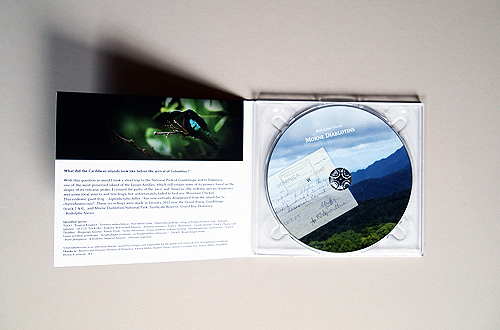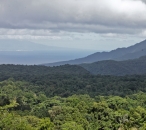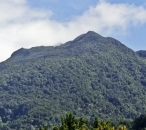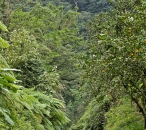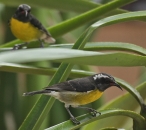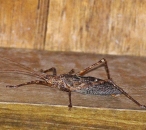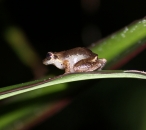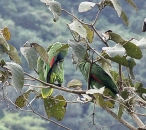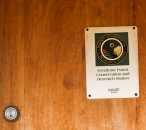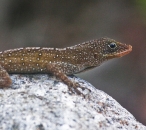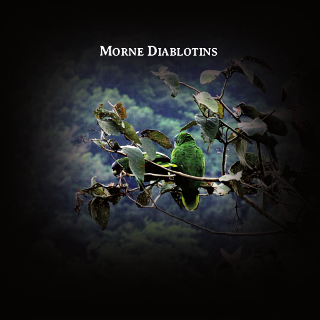
MORNE DIABLOTINS | Rodolphe ALEXIS
A walk among the Lesser Antilles, Guadeloupe and Dominica
Gruen 139 | Audio CD > [order]
What did the Caribbean islands – acoustically- look like before the arrival of Columbus? With this question in mind I took a short trip to the National Park of Guadeloupe and to Dominica, one of the most preserved island of the Lesser Antilles, which still retains some of its primary forest on the slopes of its volcanic peaks. I crossed the paths of the ‘Jaco’ and ‘Sisserou’ (the endemic species of parrots), met some local insects and tree frogs, but unfortunately failed to find any ‘Mountain Chicken’. This endemic giant frog – Leptodactylus fallax – has now virtually disappeared from the island due to chytridiomycosis*. These recordings were made in January 2013 near the Grand-Etang, Guadeloupe (track 1 &4), and Morne Diablotins National Park, ‘Syndicate Reserve, Grand Bay, Dominica.
Morne Diablotins“ is the proper name designating the National Park of Dominica and its eponymous volcano. That name comes from the old French, at the time when the „Dominique“ was still under French governance. In french it can have a double-entender, with the word „Morne“ meaning „mountain“ but also „low“, „sad“, „dull“ and the word „Diablotins“ meaning „little devils“, with a friendly feeling – Rodolphe Alexis
*Chytridiomycosis is an infectious disease caused by a fungus and responsible for the global and critical decline of amphibians worldwide.
Thanks to : Reseve and Forestry Division of Dominica, Annick Abdul, Stephen Duran, Antony Levesque, Eric Dubois-Millot, DinahBird. Photos & artwork : RA
Tracklisting :
I Before sunset 2’32
II Jaco’s pairs fight 03’44
III Noon (Dominican red-necked Amazon & faraway rooster) 05’13
MP3
IV Grand Etang at dusk 18’22
MP3
V Syndicate Reserve at dusk 09’18
VI Brown Katydid (Xerophyllopteryx fumosa ?) 04’28
VII A Night in Grand Bay 28’22
MP3
VIII Imperial Parrot & broad winged hawk 01’11
8 Tracks (72′56″)
CD (500 copies)
Identified recorded species :
Track1 : Tropical King bird – Tyrannus melancholicus – Pied Billed Grèbe – Podilymbus podiceps – wings of purple-throated carib – Eulampis jugularis – (at 2’25) Track 2&3 : Endemic Red-necked – Amazons Amazona arausiaca -Track 2 : Bananaquit – Coereba flaveola – Track 4 : Pearly-eyed Thrasher – Margarops fuscatus – Forest Trush – Turdus lherminieri – Lesser antillean endemic treefrog – Eleutherodactylus martinicensis – Track 6 : Lesser antillean grasshoper – Xerophyllopteryx fumosa – or Nesophyllidium fulvicosta ? – Track 8 : Broad-winged Hawk – Buteo platypterus – & Endemic Imperial amazon – Amazona imperialis –
Photo Captions :
01 – Le Grand-Etang, Guadeloupe National Park.
02 – View of Guadeloupe from the Morne Diablotins National Park.
03 – the Morne Diablotins (largest volcano on Dominica – 1447m).
04 – Primary forest on the slope of Morne Trois Pitons.
05 – Secondary Forest with Citrus fields (near Syndicate reserve).
06 – Bananaquit or sugarbird (Coereba flaveola) – Maybe the most common and noisy bird in the islands.
07 – Lesser Antilles brown Katydid (identified as Xerophyllopteryx fumosa), Syndicate reserve.
08 – Lesser Antilles tree frog (Eleutherodactylus martinicensis).
09 – Pair of Red-necked Amazon (Amazona arausiaca) under the rain, endemic.
10 – Lesser Antilles hummingbird, Purple throated Carib (Eulampis jugularis).
11 – the Studio at Syndicate Reserve.
12 – Dominican Anole – Atlantic ecotype (Anolis oculatus winstoni), endemic.
Field Recording Series by Gruenrekorder
Germany / 2013 / Gruen 139 / LC 09488 / SACEM / EAN: 4050486107652
Holger Adam | testcard #24: Bug Report. Digital war besser
[…] RODOLPHE ALEXIS’ Morne Diablotins (nach dem höchsten Berg der Insel Dominica benannt) schüchtert mich aber letztlich doch nicht ein. Im Gegenteil, die Aufnahmen sind sehr gut dazu geeignet, Stadtbewohner_innen ohne Balkon zumindest bei offenem Fenster und geschlossenen Augen zu suggerieren, sie säßen des Nachts auf einer Karibikinsel auf der Veranda: Es zirpt und ruft aus verschiedener Tiere Kehlen und insgesamt strahlen die Aufnahmen eine große Ruhe aus. […]
link
Rodolphe ALEXIS | MORNE DIABLOTINS @ The Wire
Derek Walmsley: The Field Recordist As Obsessive
IDWAL FISHER – an antimacassar for the hearing
[…] These last two releases are pure field recording. Rodolphe Alexis with a walk through the forests of the Lesser Antilles, Gaudaloupe and Dominica and Kubisch and Güther in the Cameroon. Both come to life with a tropical rainstorm where the heavens open and the locals get a taste of God moving his furniture about. In the Cameroon the rain peters out on a tin roof until the cicadas, birds and other insects can be heard once more with Alexis the results are even more Biblical.
Kubisch and Güther’s made a deal with the locals in a I’ll show you mine if you show me yours kind of fashion. With Cameroon being a noisy place by nature [car horns, markets, amplified music etc.] they thought that it might be in the locals interest to hear what went on outside these everyday noises. The locals then took them to places they thought might interest them, hence the church, an abandoned hotel, the river, a national park. The results veer from the chaotic [the church service] to the sublime [the end of that rainstorm] with both sides coming out winners. Holding workshops for the locals Kubisch and Güther soon realised that the locals did indeed take heed of what was going on around them ‘but so far they had not felt any necessity to store these sounds’.
On Morne Diablotins [the name of the highest mountain in Dominica] Rodolphe Alexis takes a walk with recording equipment in hand passing Jaco and Sisserou, the endemic species of parrot, but failing to locate any mountain chicken’s or giant frogs. There’s always a next time. Its his mission to record and observe giving us the purity of the rainforest in all its verdant glory.
And whilst I thought that these recordings weren’t anything out of the ordinary [preferring David Tudor’s electronic take on the rainforest if pushed into a corner for an opinion] they do draw you in. Especially on the longest and most immersive track, the 28 minute ‘A Night in Grand Bay’ where a tropical rain storm, insect chatter and the agitated calls of parrots all joyously mingle.
Bird and insects sounds dominate on all of Morne Diablotins. As they should.
Another solid set of releases from the ever reliable Gruenrekorder.
link
Stephan Roiss | freiStil – Magazin für Musik und Umgebung #54
[…] Rodolphe Alexis schließlich hat sich in die Karibik begeben und aus Guadeloupe und der Dominikanischen Republik Aufnahmen mitgebracht. Der Mensch und die Sphäre der Kultur kommen in den Tracks selbst nicht vor. Gesammelt in Nationalparks und abgeschiedenen Gegenden sind deren Protagonisten Vögel, Grashüpfer, Frösche, laufendes Wasser. Die Ausgangsfrage von Alexis‘ Reise ist diese gewesen: „What did the Caribbean islands look like before the arrival of Columbus?“ Mit morne diablotins hat er eine feinsinnige Antwort gegeben, allerdings auf eine andere Frage. Der entstandene Tonträger lässt erahnen, wie es dort anno dazumals in etwa geklungen haben mag. Unklar bleibt, wo der – im Vollsinn – künstlerische Gehalt dieses Albums liegt, sofern denn überhaupt einer intendiert war. Als Kontemplationshilfe taugen die Sounds allemal, auch als wunderbarer Reisefieber-Trigger, ebenso als Audio-Dokumente im Dienste der Biologie und des Artenschutzes. Ein Anspruch auf kompositorische Gestaltung, ein vorsätzlich ins Werk gesetzter Spannungsbogen, irgendetwas, das auf avancierte Weise mit dem Material über das bloße Material hinausginge, lassen sich hingegen schwer ausmachen. […]
Roger Batty | Musique Machine
Morne Diablotins finds Paris based field recordist & sound artists Rodolphe Alexis offering up near on seventy three mintues worth of bird, amphibian, insects and environment recordings from the Caribbean islands of Dominica and Guadaloupe. With the release posing the question ‘What did the Caribbean islands sound before the arrival of Colombus?’
The CD release takes in eight tracks in all, and these last between just over the minute mark, to just shy of the twenty nine minute mark. These tracks take in untreated recordings made by Mr Alexis in early 2013, at various sites in the national parks of Dominica and Guadaloupe. And these purely natural recordings attempt to take us back in time to the year 1493, when Colombus first discovered both islands.
I found the album started off been sonically pleasing, though more than a little underwhelming- you see it opens up with three tracks that each last between two & five mintues piece, and each these of just focus in on sonically attractive if not very engaging or rewarding parrot & exotic bird song ‘n’ chatter.
From track four onwards I found things became a bit more interesting & appealing- track four “Grand Etang at Dusk” finds Alexis taking us on a just under nineteen minute trip into the rich & detailed sonic world of Guadeloupe at dusk, with a rewarding sound map made up of thrush twitter, thrasher chirp, & tree fog chatter.
With the highlight here been the just under twenty nine mintues of “A Night in Grand Bay”- which captures the night time sounds of Guadeloupe, with it’s detailed & slowly shifting sound scape taking in: layered mix of harmonic bird song & constant grasshopper buzz. Through to close-up, then distancing sound of rushing waterfall & bird song textures. Onto rain down pours & rich/ layered birdsong structures, back to sududed & thinning out mixture of bird & insect sound.
As always with Gruenrekorder releases, sound wise the recordings here are crystal clear & wonderfully captured. Also the release comes in a rather hansom colour digipak, which takes in pictures of birds, parrots and frogs from the islands of Dominica and Guadaloupe.
So to sum-up Morne Diablotins started off pleasing-if-a-little-bland, but the later & longer tracks were far more engrossing & rewarding as Alexis really managed to capture the rich sonic structure of the islands wildlife & it’s natural surroundings
Tina Manske | Musikmag
Vor der Entdeckung
Weiter geht’s auf der Reise, jetzt in die Karibik. „Morne Diablotins“ Rodolphe Alexis versucht die Wiederentdeckung eines Landstriches. „Wie sahen die karibischen Inseln aus, bevor Kolumbus kam?“ fragte sich Alexis – bzw. wie hörten sie sich an? Er reiste in den Nationalpark von Guadeloupe und auf die Kleinen Antillen, wo es auf den Bergen noch Reste des Urwaldes zu bestaunen gibt.
Insekten, Frösche, das Erwachen der Vögel bei Sonnenaufgang, das Rauschen des Regens auf dicken Blättern, all das kann man hier wunderbar nachhören. Der Morne Diablotins ist die höchste Erhebung der Insel Dominica und eine schöne Fundgrube für Geräusche, die es so vielleicht nicht mehr lange zu hören geben wird.
link
Guillermo Escudero | Loop
‚Sempervirent‘ (2012) of Rodolphe Alexis was reviewed on loop and consist ina research in Costa Rica doing multichannel field recordings in different ecosystems of Central America.
Rodolphe Alexis is a French field recordist artist and designer who lives and works in Paris. His work is based on field recording, electroacoustic composition, radio parts and specific sites for installations or performances.
What did the Caribbean islands – acoustically- look like before the arrival of Columbus? Rodolphe Alexis with this question in mind he did a sound research in the National Park of Guadeloupe and Dominica (Caribbean Sea) and one of the best preserved islands of the Lesser Antilles. These recordings were made in January 2013 near Grand-Etang, Guadalupe (tracks 1 to 4) and Morne Diablotins National Park, a Nature Reserve in Grand Bay, Dominica.
On ‚Morne Diablotins‘ sounds of the wildlife of these unexplored places are captured: insects, different types of birds and frogs, parrots, roosters, Lesser Antilles grasshoppers, etc.
The listening experience is a possibility of being immersed in the rich wildlife diversity of these places.
Cheryl Tipp | The Field Reporter
‘Morne Diablotins’ begins with a question: What did the Caribbean islands look like – acoustically- before the arrival of Colombus? Following in the footsteps of the famed Italian explorer, field recordist Rodolphe Alexis journeyed to the Lesser Antilles in search of answers.
The islands of Dominica and Guadaloupe, both encountered and described during the second voyage of Chrisopher Colombus, provided Alexis with ample inspiration. Eight recordings from the expedition made the final cut, each one a perfect sonic postcard of exoticism for our western ears. A variety of birds, amphibians and insects lend themselves to the soundscapes, some of which bring with them more than just a pleasant listening experience. Track 8 includes the calls of the endangered Imperial Parrot, while track 2 focuses on the vulnerable Jaco Parrot. Both are endemic to Dominica and can be found nowhere else in the world; as recordings of these species are rarely found in archives, the publication has scientific value as well as the obvious aesthetic appeal.
As one would expect from Alexis, and indeed Gruenrekorder, all eight recordings are of exceptional quality. A personal favourite is ‘A Night in Grand Bay’, a 28 minute snapshot of Dominica’s Morne Diablotins National Park. It is exquisite; a delicate blend of insect and amphibian voices, complimented by rainfall that gradually diminishes as the close of the recording approaches. Perfectly balanced, perfectly judged and something that I could happily listen to again and again.
Another recording that I think deserves special attention is ‘Grand Etang at Dusk’. Coming in at just over 18 minutes, we are treated once again to a long, uninterrupted soundscape, this time recorded on Guadeloupe rather than Dominica. I find myself leaning more and more towards these longer field recordings which, when well done, give the listener plenty of time to ease themselves into the sound and all the nuances that come with recordings of this nature.
‘Morne Diablotins’ is a worthy addition to Rodolphe Alexis’ growing discography. The recordings have an eternal quality that, though contemporary creations, speak of a time before colonisation. Together they offer a window into the past and an opportunity to appreciate the natural wonders of these island nations.
link
Łukasz Komła | Nowamuzyka.pl
Wyobraźcie sobie jakie dźwięki moglibyśmy usłyszeć w lasach Wysp Karaibskich, gdyby Kolumba pożarły morskie stwory i nigdy tam nie trafił.
Francuski artysta Radolphe Alexis wybrał się do Parku Narodowego Gwadelupy i Dominiki zadając sobie podstawowe pytanie. Jak mogły wyglądać Wyspy Karaibskie – w kwestii dźwięków przyrody – przed przybyciem Krzysztofa Kolumba? Dominika to jedna z najlepiej zachowanych wysp w archipelagu Małych Antyli, a na niej znajdziemy spore połacie pierwotnych lasów, które porastają stoki wulkanicznych szczytów. Alexis zabiera słuchaczy na szlak wijący się gdzież u podnóża tytułowego wulkanu „Morne Diablotins” na Dominice. W pierwszej kolejności poznajemy uroczy śpiew papug tzw. amazońskiego perkoza („Jaco”) i amazonki cesarskiej („Sisserou”). Obie papugi traktuje się w kategorii endemicznych gatunków. Dźwiękowa przechadzka z Alexisem wśród lasów staje się tak autentycznym przeżyciem, że czuć jak pulsuje gorące powietrze, a wraz z nim niezliczone ilości różnych owadów i żab. Autor wyznaje, że nie udało mu się trafić na wyjątkowy okaz żaby jaką jest „Mountain Chicken” (tak jest nazywana w miejscowym slangu – tutaj filmik). Endemiczny gatunek tej olbrzymiej żaby jest praktycznie na wymarciu. Taki stan rzeczy wywołała choroba zakaźna spowodowana przez grzyby (chytridiomycosis), które niszczą też wiele innych płazów na całym świecie.
Jedno z fascynujących i doskonale wyważonych nagrań na tym krążku to „A Night in Grand Bay”, dzięki niemu możemy spędzić sporą część nocy w rezerwacie Grand Bay. Z kolei fragment „Grand Etang at Dusk” przenosi nas na Gwadelupę – a tam szept, śpiew ptaków, cykanie i szmer. Prawie dwadzieścia minut tego nagrania sprawia, że odbieram to miejsce nie tylko jako „hałas” jaki generuje przyroda, dla którego las pełni rolę pudła rezonującego, lecz postrzegam jako przestrzeń porażająca swoim spokojem.
Na pewno albumu Radolphe’a Alexisa nie należy traktować jako egzotycznej pocztówki dźwiękowej przywiezionej dla Europejczyków. Przede wszystkim jest to materiał niezwykle ważny pod względem naukowym i estetycznym. Z tego co mi wiadomo, to bardzo ciężko jest spotkać w jakichkolwiek archiwach nagrania odgłosów wspominanych papug. „Morne Diablotins” to płyta będąca spojrzeniem w przeszłość pozwalająca wyobrazić sobie, jak mógłby brzmieć świat nieodarty z dziewiczej natury przez człowieka-kolonizatora. Okazuje się, że temat jest tak samo aktualny dziś, jak i kilka wieków temu.
link
Brian Olewnick | Just outside
A documentation of avian, insectile and amphibious life in Guadeloupe and Dominica as well as surrounding, non-aniumal sounds. As with many similar releases I’ve encountered, it’s tough to make any sort of value judgment except to say how well or poorly the environment seems to have been captured, in this instance, very well. Choices of what to include seem based on which particular fauna have been caught on tape, lending a kind of „nature study“ feeling to the endeavor. Which is fine–clearly, you don’t need to listen to this as an art project, just vicariously troop along with Alexis as he roams the rain forests and volcanic peaks. On the one hand, you can understand his search for a Caribbean „before the arrival of Columbus“ but on the other, you wonder how far to take this avoidance of contemporary reality. There’s a decided risk of luxuriating in the exotic sounds and forgetting the world around.
And I have to admit, the sounds are pretty impressive even though, necessarily, one would really like to be surrounded by them rather than listening through speakers. Picking a „favorite“ track seems strange, but „Grand Etang at dusk“ has a lot going for it, including a wonderful, if brief, shower. I get the impression that Alexis has done some post-recording layering, not sure. In any case, while it’s not the kind of thing I’d normally find myself going out of my way to listen to, I can’t quibble with the quality of the sound–it’s routinely dense and intriguing. If you’re at all into pure, natural world field recordings, this is right up your alley.
METAMKINE
À quoi les îles des Caraïbes pouvaient-elles ressembler avant l’arrivée de Christophe Colomb ? C’est avec cette question à l’esprit, que Rodolphe Alexis a pris le chemin du parc national de la Guadeloupe et de Dominique, un pays et une île de l’archipel des Caraïbes, qui conserve encore une partie de sa forêt primaire sur les pentes de ses pics volcaniques. Perroquets, insectes, grenouilles, végétation, pluie de jour comme de nuit, une traversée de paysages encore protégés de l’activité humaine et une plongée dans un monde sonoire tellement actif et restitué grâce à la précision des enregistrements réalisés en janvier 2013.“
link
Le Son du Grisli
Après s’être demandé à quoi pouvaient ressembler les îles des Caraïbes avant l’arrivée de Christophe Colomb, Rodolphe Alexis a pris l’avion en début d’année pour la Dominique. La faune de l’île, assez préservée, lui a offert des concerts d’oiseaux, de grenouilles des arbres, d’insectes et de pluie qui tombe comme nulle part ailleurs. A écouter la nuit, pour respecter le décalage horaire, comme en signe de respect pour ce beau documentaire sonore. (pc)
link
Frans de Waard | VITAL WEEKLY
[…] We cross the Atlantic Ocean and find one Rodolphe Alexis in the National Park of Guadeloupe and in Dominica, ‚one of the most preserved island of the Lesser Antilles, which still retains some of its primary forest on the slopes of its volcanic peaks‘ to answer the question: „what did the Caribbean Island look like before the arrival of Columbus?“, although probably he meant to ask what it sounded like. Here we have no human action and ‚just‘ seventy two minutes of insects, birds and frog sounds. That might be a bit much, I was thinking, but on the other hand: it’s cold outside and if I turn up the heater a bit more, close the curtains, close my eyes, I could easily pretend to be in the Caribbean, listening to the these animal sounds (of course not sitting on a porch sipping a cocktail, as that is not what it would have sounded like before Columbus, right?). Nice for sure, but very much one thing. […]
link

